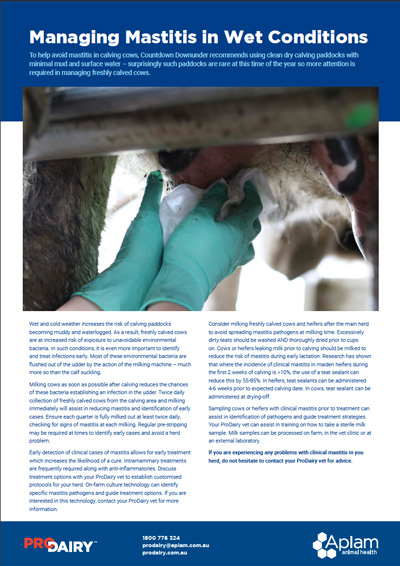To help avoid mastitis in calving cows, Countdown Downunder recommends using clean dry calving paddocks with minimal mud and surface water – surprisingly such paddocks are rare at this time of the year so more attention is required in managing freshly calved cows.
Wet and cold weather increases the risk of calving paddocks becoming muddy and waterlogged. As a result, freshly calved cows are at increased risk of exposure to unavoidable environmental bacteria. In such conditions, it is even more important to identify and treat infections early.
Most of these environmental bacteria are flushed out of the udder by the action of the milking machine – much more so than the calf suckling.
Milking cows as soon as possible after calving reduces the chances of these bacteria establishing an infection in the udder. Twice daily collection of freshly calved cows from the calving area and milking immediately will assist in reducing mastitis and identification of early cases.
Ensure each quarter is fully milked out at least twice daily, checking for signs of mastitis at each milking. Regular pre stripping may be required at times to identify early cases and avoid a herd problem.
Early detection of clinical cases of mastitis allows for early treatment which increases the likelihood of a cure. Intramammary treatments are frequently required along with anti-inflammatories. Discuss treatment options with your ProDairy vet to establish customised protocols for your herd.

On-farm culture technology can identify specific mastitis pathogens and guide treatment options. If you are interested in this technology, contact your ProDairy vet for more information.
Consider milking freshly calved cows and heifers after the main herd to avoid spreading mastitis pathogens at milking time. Excessively dirty teats should be washed AND thoroughly dried prior to cups on. Cows or heifers leaking milk prior to calving should be milked to reduce the risk of mastitis during early lactation. Research has shown that where the incidence of clinical mastitis in maiden heifers during the first 2 weeks of calving is >10%, the use of a teat sealant can reduce this by 55-85%. In heifers, teat sealants can be administered 4-6 weeks prior to expected calving date. In cows, teat sealant can be administered at drying-off.
Sampling cows or heifers with clinical mastitis prior to treatment can assist in identification of pathogens and guide treatment strategies. Your ProDairy vet can assist in training on how to take a sterile milk sample. Milk samples can be processed on farm, in the vet clinic or at an external laboratory.
